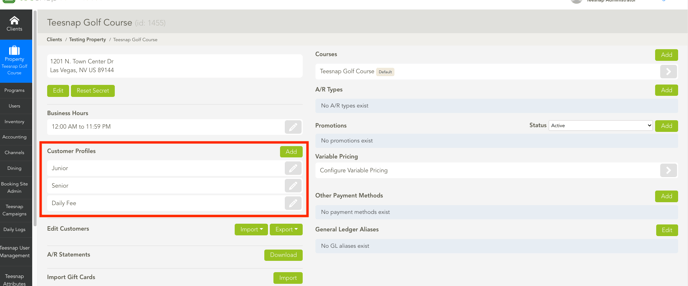Managing Your Database With Customer Profiles
Utilizing player profiles in your database not only helps organize your database into manageable groups but also lays the groundwork for success in two important areas:
- It guarantees that the pricing for each golfer is accurate every time by utilizing profile pricing.
- It serves as the cornerstone for both your email marketing strategies and automated marketing campaigns.
When developing player profiles, Teesnap designed a “Rules Engine” that attaches a price for golf for that profile based on time of day and day of the week. Profile pricing eliminates incorrect charges to customers from your pro shop personnel and reduces training time.
When you take a golfer from the tee sheet to the shopping cart his/her price starts from the rack rate on your tee sheet but is referenced against the player profile pricing as set up in your admin portal.
When you design this, the system then knows the price for all of your profiles and customers.
Teesnap’s green fee system is SKU-less. This eliminates that long list of greens fees in the shopping cart. As a pro shop employee, there is no more hunting through a never-ending stream of outdated green fee SKUs to choose a golfer's price. Using player profiles and profile pricing ultimately increases your customer service and control at the counter.
How this works:
1. Decide on your player profiles that fit your facility and create them. (ie) Daily Fee, Senior, Member, Non-Resident, Junior, Employee, etc.


2. Within the Teesnap Admin Portal, configure the pricing associated with each player profile based on the specific time of day and day of the week outlined in your tee sheet setup.

3. Educate your staff to assign a player profile to every customer when adding them to the database or making a reservation.
4. The next time this customer checks in, their correct prices will automatically be sent to the shopping cart.
The setup is easy, but #3 is the KEY. Train the staff about the “why!” New golfers are hard to find and attract. There shouldn’t be any excuse as to why we can’t collect information on the golfers that are visiting us. This allows us to re-market to existing golfers in our database. This enables us to increase revenues.
When training new pro shop personnel, the ability to use the rules engine is very valuable. It takes some time for new pro shop staff to learn all of the members and their names. When this is set up at your property, when the member is taken from the tee sheet into the shopping cart, the system assigns the correct rate into the cart with that member. This minimizes training errors and also increases customer service to that member at the time of check-in. “Oh, Mr. Smith, I see that you are a member. Nice to meet you! I am Jane – would you like that to go onto your account?” This also works the same way for daily fee, league players, players card holders, etc.
TEESNAP MARKETING TOOLS
Player profiles and segmentation in your database will also enable you to utilize the Teesnap Marketing tools to their full potential.
Here are a few simple email marketing ideas for individual sends based on profiles:
- Notifying the regulars about a new league or offering they may be interested in.
- Emailing the league results to the regular league play.
- Notifying all of the members about the events calendar for the new year.
- Marketing the next member event to the members.
- Emailing yearly seasonal customers about their regular tee times 2-3 months ahead of time before their arrival.
- Emailing the stay and play customers about their rebooking.
I mentioned earlier “Automated Marketing Programs” because these programs are more than just email campaigns. To me, an email campaign might be informing the masses of an upcoming tournament, event, or golf special. However automated marketing programs are well-thought-out marketing campaigns that utilize your Teesnap transactional data to grow revenues. These programs are automated and are triggered by events in your database. You design them, control them, and monitor them to grow rounds and revenue. Once you set these up to run, they are marketing messages, offers, and communications that run every day based on your data. Profiles are important for these because they will often be used in the criteria of setting these up.
.png?width=240&height=55&name=Untitled%20design%20(86).png)